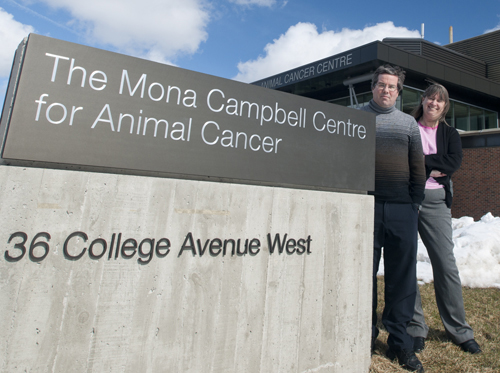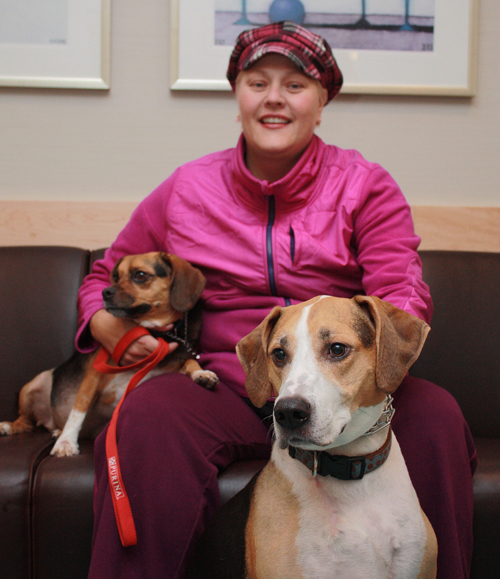By Karen Mantel and Jane Dawkins

It takes time to grow an investment – ask your banker or financial advisor.
Or you could ask Prof. Brenda Coomber, co-director of the Institute for Comparative Cancer Investigation (ICCI) at the Ontario Veterinary College (OVC). She sees the value in a long-term investment, built over time with care and commitment.
You can’t buy what Coomber and her colleague, Astrid Cuncins-Hearn, tumour bank and clinical trial co-ordinator, are saving in ICCI’s companion animal tumour sample bank. “It’s more than a bank,” says Coomber. “It is really a safety deposit box for our future.
“What we’re storing isn’t something with numerical value, but it has the potential to discover new diagnoses and new cures – to move towards better therapy for both animals and humans.” She adds, “You can’t compare what’s saved in this bank to material goods.”
This bank is tucked inside OVC’s Mona Campbell Centre for Animal Cancer, the most comprehensive animal cancer research and treatment centre in the country. And Coomber says this is the only tumour bank in Canada dedicated to veterinary samples.
You can’t have an animal cancer centre without research and development as part of the education component, says Cuncins-Hearn. For the last two years, the OVC tumour bank has had a full-time person connected to it. She says this has helped increase sample collection.
A bank can’t dispense assets until it collects them. At present, the tumour bank has over 2,000 tissue and fluid samples from 243 pets with cancer, but it has lots of room for growth and endless opportunities for research. Coomber would like to see at least 1,000 different cases.
She says OVC is building a biospecimen repository for the study of cancer. Comparative oncology – comparing naturally occurring or spontaneous cancers across species – is gaining increasing prominence. The tumour bank can play a role in these studies.
For example, dogs possess both anatomic and physiologic similarities to humans in terms of their cancer pathogenesis and associated genes and proteins. As well, similar environmental, nutrition, age, sex and reproductive factors lead to tumour development and progression in both dogs and humans. Some cancers, such as osteosarcoma, lymphoma, melanoma, bladder cancer and feline mammary cancer are extremely similar, says Coomber.
“Cancer in both animals and people is not something that has developed overnight, and it will not be cured overnight, but if we can build a large enough bank of samples, it will mean we have better information and better potential to discover therapy and prevention measures for animal cancer in the future.
Coomber adds, “It is this hope that guides us and this hope that motivates generous pet owners to make the decision to donate samples in the midst of making other critical life choices for their pets.”
Prof. Paul Woods of the Mona Campbell Centre for Animal Cancer is ICCI co-director with Coomber. He says, “The families of pets with cancer and their veterinarians are encouraged by the possibility of the tumour bank helping future pets and perhaps people.
“When a pet’s tumour is removed by our surgeons, only a small part of the tumour is needed by the pathologists for diagnosis; much of the tumour would be discarded. However, with the tumour bank, we are saving that invaluable tumour resource for investigation by future veterinary and human-based cancer researchers for better ways to diagnose and treat cancer,” says Woods. “Our pets and their families with the support of the Pet Trust are helping us to better understand cancer.”
Lorraine Brown received the devastating news that Rinnie, her four-year-old Beagle cross, had a mast cell tumour just one-and-a-half weeks after Jazzmine, her nine-year-old Beagle cross, had surgery to remove the same type of tumour.
When asked if she would donate samples of the tumour to the bank, there was no question, says Brown. “They didn’t have to go into detail,” says Brown. “We thought if there is anything that would help in the future; we’re interested in seeing advancements being made.”
 Lorraine Brown with pets Rinnie and Jazzmine
Lorraine Brown with pets Rinnie and Jazzmine
Both Rinnie and Jazzmine required follow-up chemotherapy after their surgery. Jazzmine was finishing her last round of chemotherapy in mid-November and Rinnie has received five of eight treatments.
Each of her pets has had few side effects from the chemotherapy, says Brown. They had an unbelievably quick healing rate following surgery and, except for some diarrhea, you would never know they are sick, she says.
“We collect from all patients that are suitable,” says Coomber. To qualify for the tumour bank, there are a number of criteria: pathology and diagnostics always come first, and the pet owner must give consent.
“It’s critical to bank the tumour where the animal is treated to ensure we have quality, well-documented samples in our bank. Knowing exactly what treatment the patients have gone through, whether they had radiation or chemotherapy before surgery, is key for consistent quality in future research outcomes,” she adds.
Cuncins-Hearn checks the surgery list and then speaks to the veterinary clinicians and owners about potentially donating a sample from their pet’s tumour to the bank. For diagnosis and evaluation of the extent of tumour invasion, most of the tumour tissue sample is submitted for examination by a veterinary pathologist. In most cases, the tumour sample is large enough that the bank will also receive a tumour piece to bank. To maintain the best integrity of the molecules for future study, the sample needs to be snap frozen within 30 minutes and stored under ultracold conditions.
“When we consent the owner to submit their pet’s tumour, we make it clear it won’t impact the pet’s clinical pathway,” says Cuncins-Hearn.
“There are fewer feline cases in the bank, with only 11 at present, so we know we underrepresent cancer in cats,” says Coomber. “This is an area where we definitely want to increase the number of samples collected.”
She explains that cats typically have smaller tumours, which aren’t optimal for sample banking, and more often present with lymphoma, which isn’t treated through surgery.
Current capacity allows the team to collect about 150 samples per year. While this may seem like a slow process, Coomber says all good investments take time and patience to ensure a quality bank.
The centre is also exploring other options to help build up the collection. A satellite bank, which could collect blood and tissue samples for DNA, is one idea being discussed. While not an actual tumour bank, this would be useful for studies into genetic patterns and hereditary markers associated with the development of cancer.
“My dream is to have a bankmobile that collects these kinds of samples on its travels.” says Coomber.
The tumour bank and the co-ordinator position associated with it are solely funded by OVC’s Pet Trust Fund. You can find more information about the project at www.pettrust.ca.